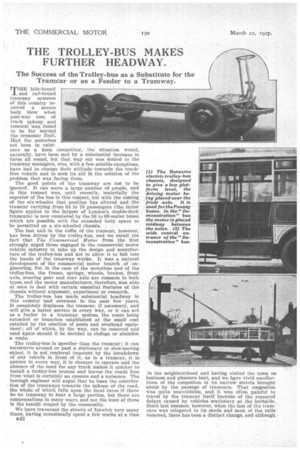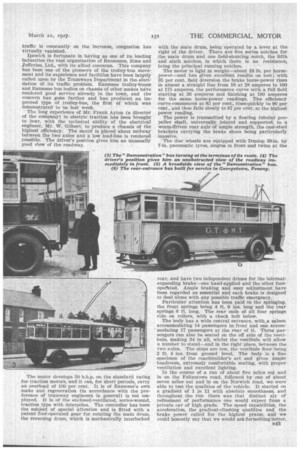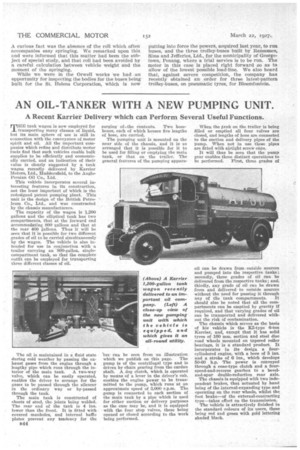THE TROLLEY-BUS MAKES FURTHER HEADWAY.
Page 68

Page 69

Page 70

If you've noticed an error in this article please click here to report it so we can fix it.
The Success of the Trolley-bus as a Substitute for the Tramcar or as a Feeder to a Tramway.
TE hide-bound and rail-bound tramway systems of this country received a severe body blow when post-war cost of track upkeep and renewal was found to be far beyond the economic limit. Had the motorbus not been in existence as a keen competitor, the situation would, naturally, have been met by a substantial increase in fares all round, but that way out was denied to the tramway managers, who, with a few notable exceptions, have had to change their attitude towards the trackfree vehicle and to seek its aid ih the solution of the problem that was facing them.
The good points of the tramway are not to be ignored. It can move a large number of people, and in this respect was, until recently, Materially the superior of the bus in this respect, but with the coming of the six-wheeler that position has altered and the tramcar carrying from 64 to 78 passengers (the latter figure applies to the largest of London's double-deck tramcars) is now countered by the 58 to 68-seater buses which are possible with the extended body space to be permitted on a six-wheeled chassis.
The last nail-in the joffin of the tramcar, however, has been driven by -the trolley-bus, and We recall the fact that The Commercial Motor from the first strongly urged those engaged in the commercial motor vehicle industry to take up the design and manufacture of the trolley-bus and not to allow it to fall into the hands of the tramway works. It was a natural development of the commercial motor branch of en-. gineering, for, in the case of the motorbus and of the trolley-bug, the frame, springs, wheels, brakes, front axle, steering gear and rear axle are common to both types, and the motor manufacturer, therefore, was able at once to deal with certain essential features of the chassis without argument, experiment or research.
The trolley-bus has made substantial headway in this country and overseas in the past few years. It completely displaces the tramcar, if necessary, and will give a better service in every way, or it can act as a feeder to a tramway system, the route being extended or branches established at the small cost entailed by the erection of posts and overhead equipmeet; all of which, by the way, can be removed and used again should it be decided to change or abandon a route.
The trolley-bug is speedier than the tramcar; It can manceuvre around or past a stationary or slow-moving object, it is not rendered impotent by the breakdown of any vehicle in front of it, as is a tramcar, it is quieter in every way, it is cheaper to operate and the absence of the need for any track makes it quicker to install a trolley-bus system and leaves the roads free from what is certainly an eyesore and a nuisance. The borough engineer will argue that he loses the contribution of the tramways towards the upkeep of the road, the whole of which falls upon the local rates if there be no tramway to bear a large portion, but there are compensations in many ways, and not the least of these is the benefit reaped by the community.
We have traversed the streets of Ipswich very many times, having occasionally spent a few weeks at a time E42
in the neighbourhood and having visited the town on business and pleasure bent, and we have vivid recollections of the congestion in its narrow streets brought about by the passage of tramcars. That congestion was quite unavoidable, and it was often painful to travel by the tramcar itself because of the repeated delays caused by vehicles stationary at the kerbside. Since last summer, however, when the last of the tramcars was relegated to its sheds and most of the rails removed, there has been a distinct change, and although
traffic is constantly on the increase, congestion has virtually vanished.
Ipswich is fortunate in having as one of its leading industries the vast organization of Ransomes, Sims and Jefferies, Ltd., with its allied concerns. This company has been one of the pioneers of the trolley-bus movement and its experience and facilities have been largely called upon by the Tramways Department in the-elucidation of its traffic problem. Ransome trolley-buses and Ransome bus bodies on chassis of other makes hare rendered good service already in the town, and the concern has gone farther and has produced an improved type of trolley-bus, the first of which was demonstrated to us last week.
• The long experience of Mr. Frank Ayton (a director of the company) in electric traction has been brought to bear, with the technical ability of the electrical engineer, Mr.. W. Gilbert, to produce a chassis of the highest efficiency. The motor is placed about midway between the two axles and a low load-line is rendered possible. The driver's position gives him an unusually good view of the roadway.
The motor develops 50 b.h.p. on the standard rating for traction motors, and it can, for short periods, carry an overload of 100 per cent. It is of Ransome's own make and regeneration (in accordance with the preference of tramway engineers in general) is not employed. It is of the enclosed-ventilated, series-wound, traction type with interpoles. The controller has been the subject of special attention and is fitted with a patent foot-operated gear for rotating the main drum, the reversing drum, which is mechanically interlocked with the main drum, being operated by a lever at the right of the driver. There are five series notches for the main drum and one field-shunting notch, the fifth and sixth notches, in which there is no resistance, being the principal running notches.
The motor is light in weight—about 19 lb. per horsepower—and has given excellent results on test; with 35 per cent. field diversion the brake horse-power rises in almost a straight line from 18 at 28 amperes to 100 at 175 amperes, the performance curve with a full field starting at 26 amperes and finishing at 180 amperes for the same horse-power readings. The efficiency curve commences at 85 per cent, rises quickly to 90 per cent., and then falls slowly to 87 per cent, at the highest power reading.
The power is transmitted by a floating tubular propeller shaft, universally jointed and supported, to a worm-driven rear axle of ample strength, the east-steel brackets carrying the brake shoes being particularly massive.
The disc wheels are equipped with Dunlop 38-in. by 7-in, pneumatic tyres, singles in front and twins at the rear, and have two independent drums for the internalexpanding brake—one hand-applied and the other footopeftted. Ample braking and easy adjustment have been regarded as essential and each brake is designed to deal alone with any possible traffic emergency.
Particular attention has been paid to the springing, the front springs being 4 ft. 9 ins. long and the rear springs 6 ft. long. The rear ends of all four springs ride on rollers, with a check bolt below.
The body has a wide central entrance, with,a saloon accommodating 14 passengers in, front and one accommodating 17 passengers at the rear of it. Three passengers can also be seated on the off side of the vestibule, making 34 in all, whilst the vestibule will allow a number to stand—and in the right place, between the two axles. The steps are low, the vestibule floor being 2 ft. 4 ins, from ground level. The body is a fine specimen of the coachbuilder's art and gives ample headroom, extremely comfortable seating, with proper ventilation and excellent lighting.
In the course of a run of about five miles out and in on the Felixstowe road, followed by one of about seven miles out and in on the Norwich road, we were able to test the qualities of the vehicle. It started on a gradient of 1 in 11 with absolute smoothness, and throughout the run there was that distinct air of refinement of performance one would expect from a private car of high grade. The speed capabilities, the acceleration, the gradient-climbing qualities and the brake power called for the highest praise, and we could honestly say that we would ask for nothing better.
A curious fact was the absence of the roll which often accompanies easy springing. We remarked upon this and were informed that this matter had been the subject of special study, and that roll had been avoided by a careful calculation hetween vehicle weight and the moment of the springing.
While we . were in the Orwell works we had an opportunity for inspecting the bodies for the buses being built for the St. Helens Corporation, which is now
putting into force the powers, acquired last year, to run buses, and the three trolley-buses built by Ransomes, Sims and Jefferies, Ltd., for the municipality of Georgetown, Penang, where a trial service is to be run. The motor in this case is placed right forward so as to allow of the lowest possible load-line. We also heard that, against severe competition, the company has recently obtained an order for three latest-pattern trolley-buses, on pneumatic tyres, for Bloemfontein.




















































































































